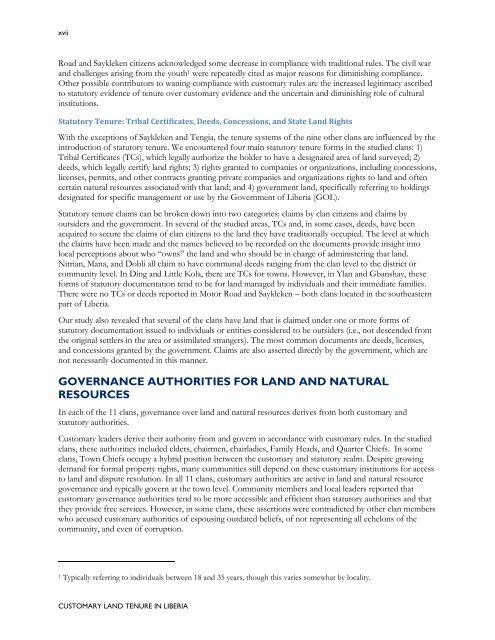Customary Land Tenure in Liberia - Land Tenure and Property ...
Customary Land Tenure in Liberia - Land Tenure and Property ...
Customary Land Tenure in Liberia - Land Tenure and Property ...
You also want an ePaper? Increase the reach of your titles
YUMPU automatically turns print PDFs into web optimized ePapers that Google loves.
xvii<br />
Road <strong>and</strong> Saykleken citizens acknowledged some decrease <strong>in</strong> compliance with traditional rules. The civil war<br />
<strong>and</strong> challenges aris<strong>in</strong>g from the youth 1 were repeatedly cited as major reasons for dim<strong>in</strong>ish<strong>in</strong>g compliance.<br />
Other possible contributors to wan<strong>in</strong>g compliance with customary rules are the <strong>in</strong>creased legitimacy ascribed<br />
to statutory evidence of tenure over customary evidence <strong>and</strong> the uncerta<strong>in</strong> <strong>and</strong> dim<strong>in</strong>ish<strong>in</strong>g role of cultural<br />
<strong>in</strong>stitutions.<br />
Statutory <strong>Tenure</strong>: Tribal Certificates, Deeds, Concessions, <strong>and</strong> State <strong>L<strong>and</strong></strong> Rights<br />
With the exceptions of Saykleken <strong>and</strong> Tengia, the tenure systems of the n<strong>in</strong>e other clans are <strong>in</strong>fluenced by the<br />
<strong>in</strong>troduction of statutory tenure. We encountered four ma<strong>in</strong> statutory tenure forms <strong>in</strong> the studied clans: 1)<br />
Tribal Certificates (TCs), which legally authorize the holder to have a designated area of l<strong>and</strong> surveyed; 2)<br />
deeds, which legally certify l<strong>and</strong> rights; 3) rights granted to companies or organizations, <strong>in</strong>clud<strong>in</strong>g concessions,<br />
licenses, permits, <strong>and</strong> other contracts grant<strong>in</strong>g private companies <strong>and</strong> organizations rights to l<strong>and</strong> <strong>and</strong> often<br />
certa<strong>in</strong> natural resources associated with that l<strong>and</strong>; <strong>and</strong> 4) government l<strong>and</strong>, specifically referr<strong>in</strong>g to hold<strong>in</strong>gs<br />
designated for specific management or use by the Government of <strong>Liberia</strong> (GOL).<br />
Statutory tenure claims can be broken down <strong>in</strong>to two categories: claims by clan citizens <strong>and</strong> claims by<br />
outsiders <strong>and</strong> the government. In several of the studied areas, TCs <strong>and</strong>, <strong>in</strong> some cases, deeds, have been<br />
acquired to secure the claims of clan citizens to the l<strong>and</strong> they have traditionally occupied. The level at which<br />
the claims have been made <strong>and</strong> the names believed to be recorded on the documents provide <strong>in</strong>sight <strong>in</strong>to<br />
local perceptions about who “owns” the l<strong>and</strong> <strong>and</strong> who should be <strong>in</strong> charge of adm<strong>in</strong>ister<strong>in</strong>g that l<strong>and</strong>.<br />
Nitrian, Mana, <strong>and</strong> Dobli all claim to have communal deeds rang<strong>in</strong>g from the clan level to the district or<br />
community level. In D<strong>in</strong>g <strong>and</strong> Little Kola, there are TCs for towns. However, <strong>in</strong> Ylan <strong>and</strong> Gbanshay, these<br />
forms of statutory documentation tend to be for l<strong>and</strong> managed by <strong>in</strong>dividuals <strong>and</strong> their immediate families.<br />
There were no TCs or deeds reported <strong>in</strong> Motor Road <strong>and</strong> Saykleken – both clans located <strong>in</strong> the southeastern<br />
part of <strong>Liberia</strong>.<br />
Our study also revealed that several of the clans have l<strong>and</strong> that is claimed under one or more forms of<br />
statutory documentation issued to <strong>in</strong>dividuals or entities considered to be outsiders (i.e., not descended from<br />
the orig<strong>in</strong>al settlers <strong>in</strong> the area or assimilated strangers). The most common documents are deeds, licenses,<br />
<strong>and</strong> concessions granted by the government. Claims are also asserted directly by the government, which are<br />
not necessarily documented <strong>in</strong> this manner.<br />
GOVERNANCE AUTHORITIES FOR LAND AND NATURAL<br />
RESOURCES<br />
In each of the 11 clans, governance over l<strong>and</strong> <strong>and</strong> natural resources derives from both customary <strong>and</strong><br />
statutory authorities.<br />
<strong>Customary</strong> leaders derive their authority from <strong>and</strong> govern <strong>in</strong> accordance with customary rules. In the studied<br />
clans, these authorities <strong>in</strong>cluded elders, chairmen, chairladies, Family Heads, <strong>and</strong> Quarter Chiefs. In some<br />
clans, Town Chiefs occupy a hybrid position between the customary <strong>and</strong> statutory realm. Despite grow<strong>in</strong>g<br />
dem<strong>and</strong> for formal property rights, many communities still depend on these customary <strong>in</strong>stitutions for access<br />
to l<strong>and</strong> <strong>and</strong> dispute resolution. In all 11 clans, customary authorities are active <strong>in</strong> l<strong>and</strong> <strong>and</strong> natural resource<br />
governance <strong>and</strong> typically govern at the town level. Community members <strong>and</strong> local leaders reported that<br />
customary governance authorities tend to be more accessible <strong>and</strong> efficient than statutory authorities <strong>and</strong> that<br />
they provide free services. However, <strong>in</strong> some clans, these assertions were contradicted by other clan members<br />
who accused customary authorities of espous<strong>in</strong>g outdated beliefs, of not represent<strong>in</strong>g all echelons of the<br />
community, <strong>and</strong> even of corruption.<br />
1 Typically referr<strong>in</strong>g to <strong>in</strong>dividuals between 18 <strong>and</strong> 35 years, though this varies somewhat by locality.<br />
CUSTOMARY LAND TENURE IN LIBERIA

















